The next set of blocks I am working on uses a complimentary color scheme of blues and oranges. I have been working with a house theme lately, and so decided to make a bunch of funky little houses. I have made about 20 houses so far, and have them up on my design wall trying to figure out how I want to put them together. All of these fabrics started off as white, and I have used several different dyeing techniques to get the patterns and colors you see here.
Sunday, April 27, 2014
Color Schemes
This weekend, I was invited to a friend's cabin in the Jemez Mountains for a girls sewing weekend! I spent a day and a half playing around with my hand dyed fabrics, starting a couple of quilts. The first one uses an analogous color scheme with reds, purples, blues, and a touch of green. I was playing around with triangle shapes in two different sizes. After the piece was put together, I decided it must be pines in the Jemez.
Fabric Collage
These are a few little experiments that I am working on with a fabric collage technique. I first start with raw canvas--sometimes I prime it with gesso, other times I just go right in with acrylic paint. I paint pieces of canvas about 18 x 22 inches, with layers and layers of acrylic paint. I use different techniques to add the layers--paint scraping, stamping, freehand mark making, stencils, splatters, etc. to create colorful and patterned pieces of fabric. Then I cut them up and applique them to a base fabric. All of the fabrics here were hand painted. I don't usually have a piece planned out completely, but have an initial idea of what shapes I will be using, and then I play around with the layout before I stitch them down. Here are 2 houses, and some flowers in progress.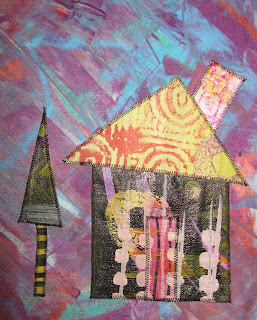
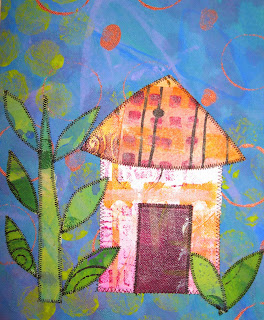




Black and White
The paper cutout project got me to thinking about contrast. I am used to working with contrast in quilting—many times patchwork patterns are relatively high contrast, so that the design can be seen. Recently, a couple of quilting friends and I were experimenting with Notan, which uses only black paper cut out and placed on a white background. We worked out some paper designs, but I think that some of these could be worked out as applique patterns, or perhaps stamps or stencils to create surface designs. Tessellations are another concept that I would like to play around with, with both paper and fabric.
Collage
I wasn’t new to the process of collage, but the class project was the first time that I have done collage with images that I did not create myself. And to further the challenge, only using images of the word that we were given, in my case, eyes. I found the process challenging, but enjoyable. The types of collage that I have done in the past are using papers that I have painted and stamped, and cutting or tearing them into shapes to create the collage. I further paint, draw, and collage on the canvas to create the picture. I like working in layers, and using recycled or handmade papers to make my collage. I also do a form of “fabric collage” which is basically the same concept, except for using fabric instead of paper. Sometimes I have a design plan in mind, other times I cut shapes at random and arrange them into a composition. (Add some quilting lines to them, and they are really fun!)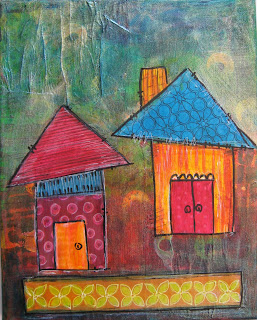
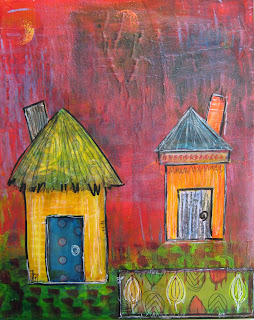
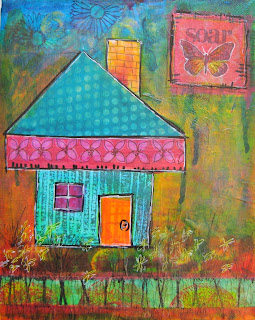
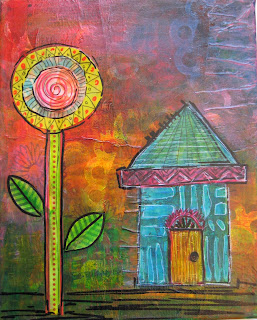






More on Line
Ah, continuing with my love for line. A couple of years ago, I took an online art class that included doing large doodles using a brush and india ink. At first, I was very reluctant to work large (say 18 x 24 inches), and I had never done much with a brush and ink. But, after doing one or two paintings, I found the process very freeing. I love using a brush to create large, gestural strokes. I love the way that a brush with ink creates an imperfect quality of line, unlike a pen, pencil, marker with all the same width of line. I could begin to control the brush to get wider lines, thinner lines, big expressive lines-- and not obsess about doing a “perfect”, tight, small drawing. I forced myself to work quickly, not think too much, and just keep my hand moving doodling, filling in the space of the page with line. I firmly believe that the more you do, the better you will become. I recently filmed this process and posted my first Youtube video. The video takes about 5 minutes to watch, but in real time took about 30 minutes to create. I really didn’t have a clear plan before I began the painting, but a vague idea of painting a vase with flowers, but each stroke I put on the page led to the next idea, and the next…
Line in Quilting
I love line. Line is my job. My job is to take a pieced or appliqued top, and sandwich the layers of top, batting, and backing together. Then I do machine quilting to hold the layers together, and to add a decorative element to the quilt. Some of the lines I add are for the purpose of utility, some of the lines I add are for decorative purposes. I have to make the decision of what type of line (straight or curvy?), the quantity of the line (dense or loose quilting?), what is the color of the line (to blend or contrast with the fabric, solid color or variegated, matte or metallic thread?) Are the quilting lines to be a focal design element, or blend into the background and let the pieced design be the star? I have quilted over 2,000 customer’s quilts, and probably a few hundred of my own. No two are the same. The design process starts over every time, and basically boils down to how am I going to use the line that my sewing machine creates to add a design element to a quilt?
Handwritting as Art
I enjoyed watching the PBS video with El Anatsui. One of the things that struck me was how when he was a little boy, before he could read, he was enthralled by lettering on buildings. Even though he couldn’t read, he liked the look of the letters, their lines and curves. He spoke of how interesting he found the letter “G”—something like a “C”, but more intricate. He spoke of how he would draw out the letters even though he didn’t know what they were. That interview struck home with me—I love looking at different written languages, Japanese, Chinese, Arabic, Russian, for their elements of linear design. I remember when my daughter was in 3rd grade, and learning how to write in cursive. Her homework each night was to write the same letters over and over again. aaaaa ccccc, etc. She got so bored with it, that suggested that she combine the letters in different patterns. After she did that for a bit, she says, “Mommy, this looks like your quilting designs”. True enough! Now, I use that as a teaching exercise when I am teaching free motion quilting, for people to start with designs they know, and what is more natural than writing. They make up different quilting patterns out of e’s or l’s or combinations of letters. I love to look at people’s handwriting—the loops and curves, the character of the line, that is unique for everyone. What is more unique than a signature? Our handwriting is an artistic expression of ourselves. The art of Calligraphy, the art of Graffiti, artistic Journaling….
Sunday, April 6, 2014
I Am For An Art
I used to compose haiku as I was trying to drift off to sleep--something to distract my mind from all of the stresses of the day, and to take my mind off of the endless "To Dos". Now, I have been finding myself composing "I am for an Art" statements instead. They are quirky and fun, and a great way to engage my mind to get to sleep.
I am for an art exploding with color like a rainbow on acid.
I am for an art that sticks with you like a piece of popcorn stuck in your teeth.
I am for an art that washes over you like a tsunami.
I am for an art that breaks through the clouds like the sun on a rainy day.
I am for an art that holds you with suspense and curiosity like a train wreck.
I am for an art that brings a breath of fresh air, like the scent of Glade in a stinky bathroom.
I am for an art that satisfies like a good scratch behind a cat's ear.
I am for an art that is as crazy as a lunatic who escapes from a mental asylum.
I am for an art exploding with color like a rainbow on acid.
I am for an art that sticks with you like a piece of popcorn stuck in your teeth.
I am for an art that washes over you like a tsunami.
I am for an art that breaks through the clouds like the sun on a rainy day.
I am for an art that holds you with suspense and curiosity like a train wreck.
I am for an art that brings a breath of fresh air, like the scent of Glade in a stinky bathroom.
I am for an art that satisfies like a good scratch behind a cat's ear.
I am for an art that is as crazy as a lunatic who escapes from a mental asylum.
Subscribe to:
Comments (Atom)





